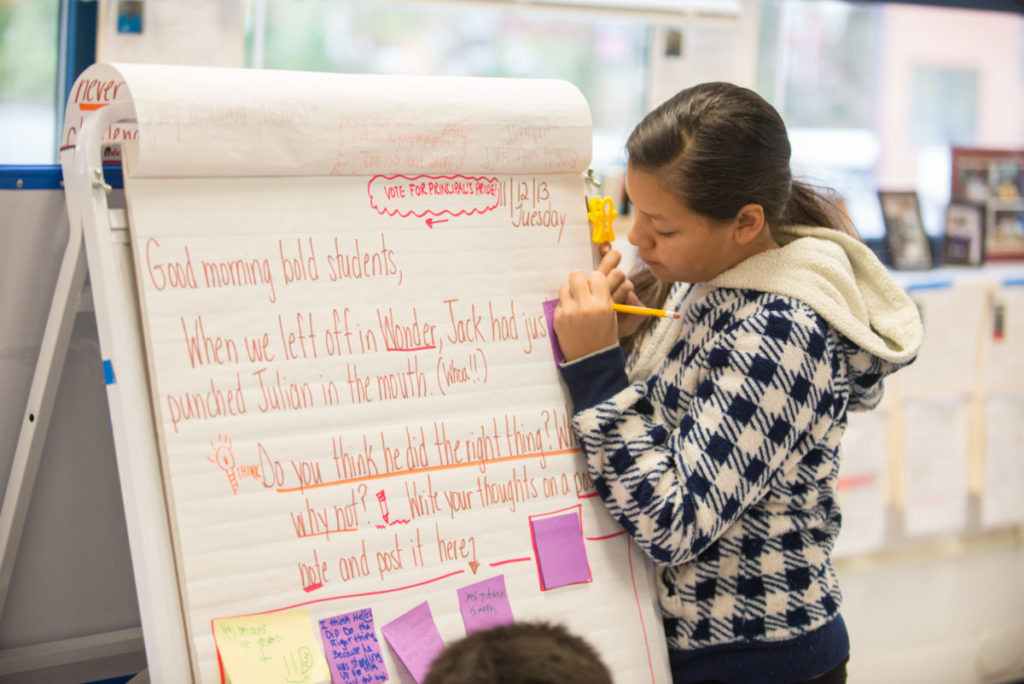
Responsive Classroom Morning Meeting is a great way to set a positive tone for the day of learning ahead while also having fun and building community. It’s also a great way to give students rich experience with the language arts. Into each meeting component—greeting, sharing, group activity, and morning message—teachers can incorporate quick, engaging language arts activities that offer practice in skills and concepts students have been learning or that pique their interest in new skills and concepts they’ll soon be introduced to.
In the words of linguist Benjamin Whorf, “Language shapes the way we think, and determines what we can think about.” As teachers, we’re perhaps more aware than most of how crucial the language arts are to students’ success in school and beyond. After all, students need language not just to read literature and write stories but also to describe their solutions to math problems, ask questions about science experiments, and share the results of their history research. And with the advent of guidelines like the Common Core State Standards, we’re focused on finding even more ways to work meaningful reading, writing, speaking, and listening into each day’s teaching.
Morning Meeting offers an ideal opportunity to give students just such rich daily experience with the language arts. Designed to enhance regular lessons, never to replace them, Morning Meeting language arts activities give students extra exposure to language arts content. In the normal flow of a meeting, students can practice several Common Core skills as they greet each other with expression, share opinions about books they’ve been reading, act out different points of view in a poem, and wonder together about the meanings of new words.
Students can also begin to develop a lively curiosity about a topic their teacher will introduce formally during language arts block. For example, a fourth grade teacher uses Morning Meeting to entice students to think about commas, something they’ll be focusing on in language arts that day. Before coming to the meeting, students read this message from their teacher:
Yes, Writers, commas do count.
My, oh my, we’re going to learn so much about commas this week! When we use commas strategically, we help our reader understand our meaning. Look at the sentences below and put a tally mark next to the one you think uses the comma correctly.
His best friend, Teresa, was late.
His best friend Teresa, was late.
His, best friend, Teresa was late.
Then, during Morning Meeting, the students greet each other with a simple “Hello, Jenny” or “Good morning, Josue,” using a curved hand to pantomime the comma; use the same pantomime as they share a list of three things they need to do after school; learn a funny song about how commas are used; and finally read the morning message chorally, making a click sound each time they come to a comma. With this introduction to commas, the class is well primed for focused learning on the topic later in the day.
As you think about incorporating activities like this into your Morning Meetings, keep these tips in mind:
Whether used daily, weekly, or occasionally, these language arts activities for Morning Meeting do much to reinforce students’ prior language arts learning and whet their appetites for more. They’re a great way to deliver the “just a little extra” that teachers continually strive to give each student.
Jodie Luongo, Joan Riordan, and Kate Umstatter are Responsive Classroom consulting teachers. Together, their teaching experience spans kindergarten through the upper elementary grades, urban and suburban settings, and public and independent schools. In addition to classroom teaching, they present workshops on the Responsive Classroom approach to educators throughout the country.
Learn More: